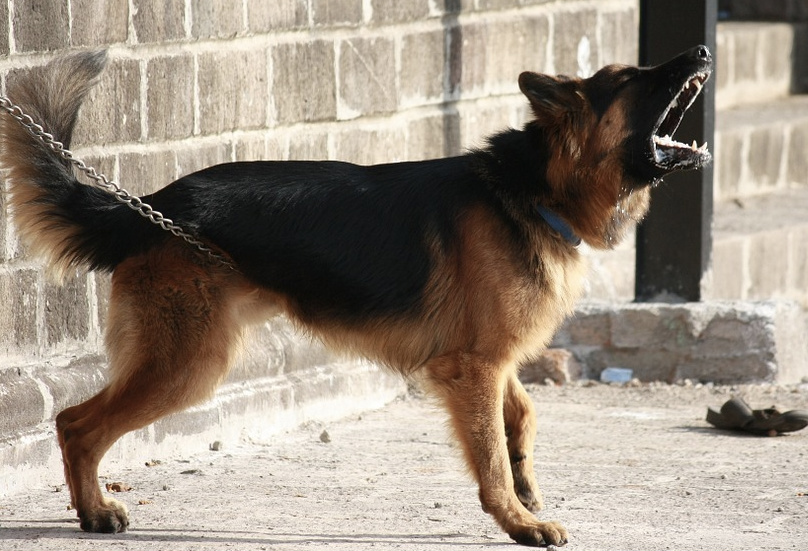Can dog’s learn English? Can they actually understand the words? If you’ve been a pet parent for any length of time, you’ll know that your dog is pretty smart. But did you know that it’s possible to teach him English words?
Connect with a verified veterinarian in minutes. Licensed vets are available 24/7 to answer your questions. No need to worry about your furry family member.
Now, we’re not saying your dog will speak to you in English—no! Not yet, anyway! What we’re talking about is a dog learning to associate words with objects and actions. Dogs are smart and have become attuned to humans and human language since they were first domesticated. Over the thousands of years we’ve had a relationship with canines, dogs have been trained and bred to listen and respond to our verbal commands.
For instance, consider Border Collies who are shepherding dogs. It’s often said they “keep their eyes on the sheep and their ears on the farmer.” These dogs listen to the commands of the farmer as to what to do with the sheep, which direction the sheep need to go, etc. Border Collies understand these commands after being taught.
It’s not only Border Collies that can learn words, but your own fur baby can learn English, too!
Teach Language to Dogs
Can a dog really learn to associate words with objects and actions? The short answer is yes. In fact, teaching him English will help you and your dog to bond at a deeper level. He’ll begin to understand what you’re saying, not only associate the sounds of words with what you’re requesting him to do.
Remember that in the beginning, your dog will listen for sounds, rather than words. He can learn to associate specific sounds and intonations with actions you’d like him to do. With patience and time, you can actually teach him the meaning of those sounds—so don’t give up—your pup is smart and loves the challenge of learning new things!
What words do dogs understand?
We already know that dogs can learn to understand basic commands, such as “sit,” “down”, “drop,” etc. through training. But science has proven that dogs are able to do much more than just understand basic commands. If trained properly, dogs can learn even more; in fact, dogs can learn 100 words or more when they’re trained to associate words with actions and reactions.
Any breed of dog can learn our words, but keep in mind that dogs are individuals. Some will learn more easily and faster than others. This is normal and to be expected.
If you’d like to train your own fur baby to better understand English, then it will take some patience, repetition and positive reinforcement to help him learn
Dogs can learn the names you give their toys, they can learn the names of family and friends, and much more. You’ll find that your pup will quickly learn the words associated with his favorite activities; however, it may take a little longer to learn other words. Your dog could even learn the word for “tree,” specific foods and more! How exciting is that?

Review symptoms, medications & behavior to keep your pets healthy with a Vet Online in just minutes.
Ask a Vet Live NowTeaching Your Dog Words
As we noted earlier, it will take some time, patience and repetition to teach your dogs English words. But don’t give up! If you make this a fun, interactive activity, you and your dog will enjoy this time spent together. How do you teach words to your dog? Let’s take a look.
1. Always keep it simple: focus on teaching your dog one word at a time. Think of how it when you learn something new—it takes time and concentration to master it. It’s the same for your fur baby. So, focus on one word at a time and don’t try to teach your dog a new word until he’s learned the first word.
2. Consistently repeat the word: you’ll have to consistently repeat the word as he performs at the action or reacts in the way you’d like. For instance, always say the word “sit” when he’s starting to sit. This way, he’ll come to associate the word and sound with the action of sitting.
3. Keep your tone pleasant and happy: dogs are like us—they respond better to a happy, pleasant tone. This is part of positive reinforcement training. Yelling at your dog, swearing at him, etc. will only scare him and reinforce his disappointment in not pleasing you. Instead, use a happy, pleasant voice and match it with a happy face! This will keep things light and fun for both of you.
4. Keep treats on hand: treats are a great incentive and/or reward you can use when training your dog. Say the word to your dog, and when he responds correctly, then reward him with his kibble or other treat.
5. Start teaching your dog the words for objects: similar to teaching your dog the words for actions, you can teach him the words for things. Be sure to use toys or other objects that have a high value for your fur baby. For instance, choose his favorite toy, food, etc. Choose one toy to use at a time and be sure the area is free of all other dog toys. You want your fur baby to focus on one specific toy at a time. Hold up the toy and say the name you’ve given it. For instance, if your dog’s favorite toy is a blue Frisbee, then say “blue Frisbee.” Then throw the Frisbee and tell him to fetch it—being sure to say something like “fetch blue Frisbee.” You don’t need to use proper grammar—just something simple your dog can learn.
6. Keep using this technique: keep using this one toy until your dog understands the name for this toy is “blue Frisbee,” or whatever it is you’re using. It could be a “red ball”—whatever toy you choose, just make sure this is one of your dog’s favorites. Repeat the name of the toy, play with your dog and the toy, being sure to repeat the toy’s name over and over. This may get old, but it’s what you’ll need to do in order to train your dog to understand this is the toy’s name.
7. When to start with a new toy: once your dog’s learned the name for one toy or object, then you can move on to teaching him the word for a new object or toy. Repeat the steps from 1-6 until your dog understands the new word. Do this for each new word you want him to learn.
Basic Commands to Teach a Dog
When it comes to commands, you can also teach these words to your dog. You’ll need to use positive reinforcement training methods, along with repetition (see the previous section for details) to teach your dog basic commands.
Here’s a dog command word list that you can teach your dog:
- Sit: for when you’d like your dog to sit.
- Down: use when you need your fur baby to lay down.
- Stay: for when your pup needs to stay in one place—this can be sitting or standing—just let him know what you want. You can say “stay and sit,” for instance.
- Heel: this is a great command to teach your dog. You use it to keep your dog walking on your left side when on the leash.
- Wait: this is a great command for times your pup needs to wait for you or for something. You might use it when you’re getting ready to leave the house. Maybe you need to get your pup’s leash, but he knows you’re taking him for a walk. Telling him to “wait” lets him know he has to wait until you give him the command to go out with you. In the mean time, you can put his leash on as he’s waiting!
- Come: this all-important command is for times when your dog may be off the leash and you need him to come right now to you. This will help to keep your dog safe if he runs away or if he’s gone off with some other dogs, etc.
- Off: this is another helpful command to teach your fur baby. Maybe you don’t want your dog on the furniture. Teaching him “off” will also help if he’s jumping on someone, etc.
- “Take it” and/or “drop it”: these commands come in handy when you’re trying to get your dog to take something (like a toy) or drop something that he shouldn’t have.
- No: this is a basic command your dog needs to learn. He will need to understand when he’s not supposed to do something—when he hears this word, he needs to know to stop whatever he’s doing at the time.
These are some helpful commands that all dogs should learn. Not only will he mind you, but he’ll know exactly what you expect when you give him these commands. They’re easy, but it may take a few repetitions before he learns them.
Remember to work on one command at a time and use the positive reinforcement method, then you’ll both have a good time as you learn
Teach My Dog to Say Words
You may have seen those cute YouTube videos where a dog seems to be speaking in English! If you’d like to teach your dog to do this, then you’ll need to choose a simple phrase that is easy for a dog to speak to you. It will take some patience and repetition, along with his favorite treat! Some breeds of dogs can be taught to speak easier than others. Those that like to “talk” include Beagles, Border Collies, Siberian Huskies, amongst others.
You might choose a phrase such as “I love you.” Next, you’ll need to repeat this phrase to your dog and get him to try to imitate your words. You’ll need to focus on one word at a time. Whenever he says a word correctly (or as nearly as possible), then reward him with his favorite treat. Do this right away to encourage him to keep trying to learn these words. Then keep practicing until your pup has learned each word and can say them together. Be sure to reward him when he gets it right.
This can be a cute way to show others how smart your dog is! But be warned—he may to learn to get attention and/or a treat when he says it to you!
It’s possible to teach your dog to understand words—you’ll just need to be patient, repeat the process and give rewards until he knows what you’re talking about. And if you teach him a phrase, be aware he’ll learn very quickly how to use it and get what he wants from you!
Related Sources: TUFTS.Edu National Geographic Scientific American
Connect with a verified veterinarian in minutes. Licensed vets are available 24/7 to answer your questions. No need to worry about your furry family member.

Kim
Kim is a talented author, who loves animals especially dogs. She engaged in writing books and articles relating to animals a decade ago. Kim resides in Chicago with her husband and son. The family is the proud owner of a dog and a parrot (Jack and Lily). Kim wanted more than these two pets, but her husband put his foot down... She often visits elementary schools to talk to the kids about what she learned about pets and how they could learn from them.
Review symptoms, medications & behavior to keep your pets healthy with a Vet Online in just minutes.
Ask a Vet Live Now



